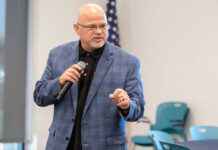Earlier this month, during my regular monthly office hours in Maricopa, I received a visit from a resident of the Hidden Valley area, Mr. Jess Nelson. He was clearly agitated with the county. He shared with me much of what he’s included in his letter to the editor. Despite my attempts to clarify matters, the information I shared in return was apparently insufficient to satisfy his concerns.
Development impact fees are a time- and court-tested way for local governments to get new development and growth to “pay for itself” by assessing a one-time fee on new construction to assist the county (or city) in constructing capital projects that benefit those new residents. The fees collected may only be used to buy equipment or build facilities – in other words, the government collecting the impact fee can purchase a police car or construct a sub-station. Operational expenses such as salaries and staffing cannot be funded with impact fees.
Impact fees must be tied to a service that government provides, must be based on a legally defensible unit cost for that service, and must be spent to create infrastructure that benefits the area in which the fee is drawn. Fees generated in the Maricopa area must be spent on infrastructure or facilities in the Maricopa area.
Counties are restricted by state statute to creating impact fees in four areas: transportation (roads), public safety (law enforcement), parks and open spaces, and water systems (wastewater and potable water). Pinal County collects development impact fees for only the first three areas of service since we are not a water or wastewater service provider.
The voters sent me to office in 2004 with a mandate: make new growth to pay for itself. Voters said: “we’re already residents of Pinal County and pay taxes for the services we get – why should we be taxed more to build new roads and parks and fund the purchase of additional police cars that are necessary because of all these new residents?”
Based on my years of experience in municipal finance as a city official and school district governing board member, I was familiar with development impact fees and championed their use by Pinal County. Shortly after my election, I joined my fellow Supervisors (Supervisors Lionel Ruiz and Supervisor Sandie Smith) in directing staff to begin the long process of developing an impact fee structure for the County. In fall 2006, the Board adopted those fees after a very long and public process.
Mr. Nelson began his conversation with me by telling me how he lived “off the grid” and that although he paid his taxes, he received no benefit for them. When we got to the issue of development impact fees, he acknowledged the logic of having new growth and development pay towards those services – but felt that his project should be exempt since he was not only “off the grid” but an existing tax payer.
I explained that the law does not give us the ability to exempt one construction project from the fee: the fees apply to classes of construction (i.e. residential, commercial and industrial) and that the largest component of the County’s impact fee goes for roads. Certainly anyone renting Mr. Nelson’s new housing units will be a user of roads, the Sheriff’s Department and, perhaps, the County’s park system even if Mr. Nelson doesn’t use those services – thus the development impact fee.
On behalf of my colleague, Supervisor Sandie Smith, I must also clarify that the Pinal County Board of Supervisors is made up of two men and one woman. Supervisor Smith was the first woman ever elected to the Pinal County Board of Supervisors. I believe the entire County has benefitted from her capable leadership.
David Snider is the Chairman of the Board of Supervisors and Supervisor for District 3 in Pinal County.
Submitted photo









![Maricopa restaurateur makes Food Network connection [Namkeen Dhaba]](https://www.inmaricopa.com/wp-content/uploads/2024/04/439456716_377105198650519_7536248579664805896_n-218x150.jpg)
![Merging lanes incite more 347 anger A merging lane sign sits on the side of State Route 347 northbound lanes during evening traffic on April 30, 2024. [Monica D. Spencer]](https://www.inmaricopa.com/wp-content/uploads/2024/04/spencer-043024-adot-merging-lanes-347-web-218x150.jpg)




